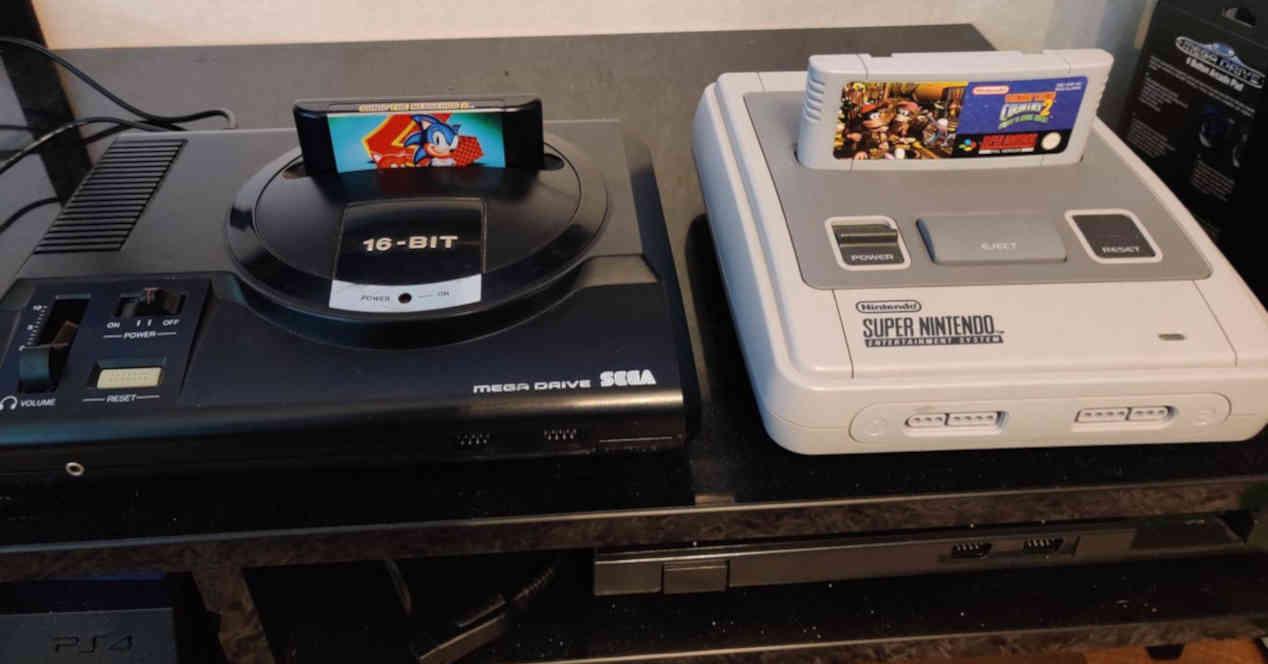Anyone who grew up in the early 90s knows that one of the biggest dilemmas was: which console is better, Mega Drive or Super Nintendo? And to this day, this controversy persists, as both had great games, but we’re not going to compare the games of each of them, but there were some hardware differences between the two.
Comparison of 68000 processors against 65C816, Mega Drive and Super Nintendo


The Mega Drive CPU is a Hitachi made clone of the Motorola 68000, which ran at a clock rate of 7.68 MHz, its characteristics are the same as a standard 68K so it has no secrets that make it special. compared to some processors of the time. In the case of Super Nintendo, its CPU is a modified clone of the 65C816, which is the 16-bit version of the 6502 clocked at 3.58 MHz. Let’s see how each of them stacks up:
- The 68K is faster in clock speed, but its RAM access is slower compared to the 65C816, but it is much simpler and doing some complex math functions requires special support chips.
- Both can address up to 24 bits, which means they support up to 16MB of RAM.
- The 68K data bus is 16 bit, while that of the 65C816 is 8 bit.
- The Super Nintendo processor clock speed depended on the cartridge ROM clock speed and it could be 1.79 MHz, 2.8 MHz, or 3.58 MHz. On the other hand, the speed of the Mega Drive processor was always the same and it did not depend on the speed of the ROM of the cartridges.
The SEGA console also had a secondary processor, an 8-bit Z80 processor. Running at 3.58 MHz, it allowed the console to run games of its predecessor, as the 16-bit SEGA contained all the hardware of the Master System, including 8KB of RAM allocated only to the Z80 which matched the RAM of the 8 bits. console, but only in Mega Drive mode are not used. Its use in Mega Drive games was to handle audio in games, which was very common on arcade cards at the time.
To the rhythm of the electron beam
Consoles in the 16-bit era used a methodology to generate the graphics, which is currently in disuse and belongs to a period when video memory was very expensive and therefore was not included in video game consoles, which has leads to the on-screen graphics to be generated at the same time as the electron beam which has passed through the television screen.
Our eyes see the image of a tube TV consistently, but it is an optical illusion created by our brain that generates the image, the reality is that the electron beam was passing very fast and that he only drew one line at a time. The advantage of this? That the items needed at all times were those needed in each scan line. So when one of these consoles drew a line on the screen, its graphics system was preparing the next one
Therefore, in order to compare these two consoles, it is necessary to understand how they both generated the image on the screen and it must be said that this has its complexity and it is impossible to understand both consoles without understanding how their video system works.
Bitmaps
The on-screen graphics of bit consoles are made up of bitmaps, which are images formed by a matrix of dots that we call pixels in which each position of the array or matrix corresponds to the color value of each pixel, between which there must be a transparent value, which indicates that there is nothing in this part of the bitmap and in the case where there is an element at the same position on the screen, but with a lower priority level , it is a question of drawing the pixel of the second object.
The bitmaps are stored in the cartridge and are dumped into a section of the VRAM from which the graphics hardware reads them to work with them and generate the screen. In Mega Drive they can be 8, 16, 24 or 32 pixels in size both horizontally and vertically, while in Super Nintendo the sizes are 8, 16, 32 or 64 pixels both horizontally and vertically. Whatever the number of pixels forming a bitmap during the generation of the image on the screen, these are interpreted by the video system called VDP on Mega Drive or SPPU on Super Nintendo, in groups of 8 x 8 pixels .
Tilemaps and sprites on Super Nintendo and Mega Drive
The second element is what is called tilemaps, they are nothing more than bitmaps but laid out like a mosaic to draw the background in an orderly fashion. They are generated by the CPU, which writes to a section of memory the address where the bitmap is located in the memory address and a series of attributes, which are usually as follows:
- Color pallet.
- Priority bit to mark in which plane is drawn.
- Bit to mark whether bitmap pixels are written left to right or right to left.
- Another priority bit to mark if the pixels of the bitmap are written backwards or in the normal way, i.e. from bottom to top or top to bottom
Mega Drive could represent up to 3 background clips, while Super Nintendo could represent up to 4 background clips, but above them was the sprite clip, which is the name given to moving elements on the screen and therefore change their screen position from frame to frame.
To create the background planes, a table of names was used for each background to draw the backgrounds, which is created by the processor in each frame during the time when the screen is not generated , while sprites are marked in what is called a “sprite attribute table”, which tracks the same attributes as the contents of each name table, but adds two additional values:
- Horizontal position of the sprite on the screen.
- Vertical position of the sprite on the screen.
And which one is the most powerful? Well, visually, the Nintendo console takes the cake, since comparatively it is able to place 128 sprites on the screen compared to the 80 of the SEGA console with about 256 colors of a palette of 32 768 colors compared to the 64 colors of the console. ‘a palette of only 512 colors. Of course, Mega Drive has placed more resolution to be those 320 pixels horizontally compared to the 256 in the SEGA console.
Audio differences between Super Nintendo and Mega Drive
The last part we have left is in the sound, the SEGA console uses a YAMAHA FM synthesizer, the YM2612, which can reproduce up to 6 sound channels at the same time. Rather, the Super Nintendo audio system is based on an 8-channel PCM system.
While the Mega Drive system functions as a program, controlled by the Z80, the Super Nintendo system uses audio samples instead. In terms of audio quality, the Nintendo console is superior, but it is limited by having only 64KB to store the audio samples, so the music was shorter and repetitive.
Table of Contents










